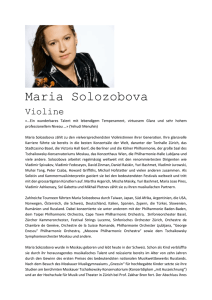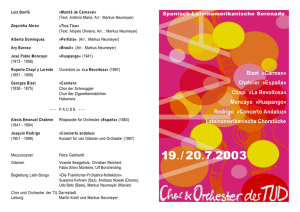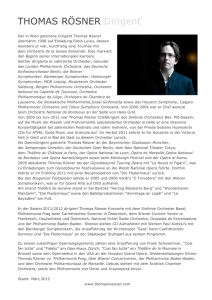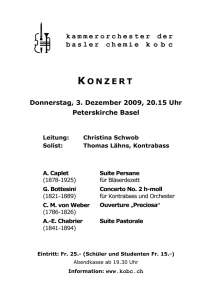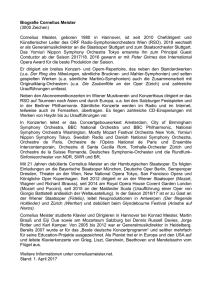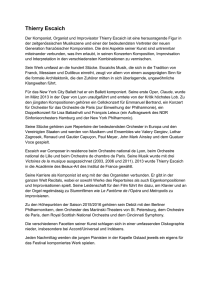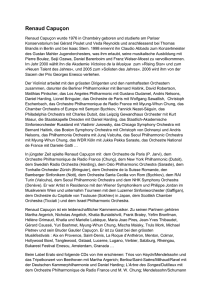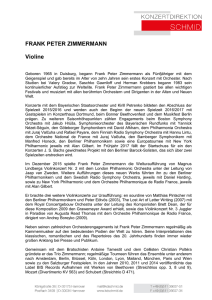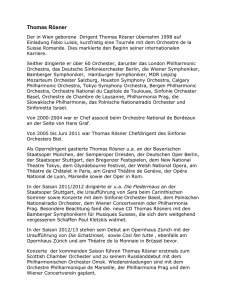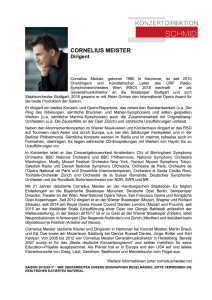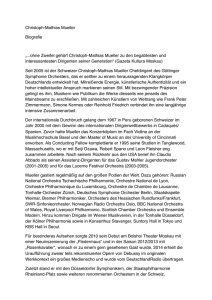orchestre de la suisse romande
Werbung
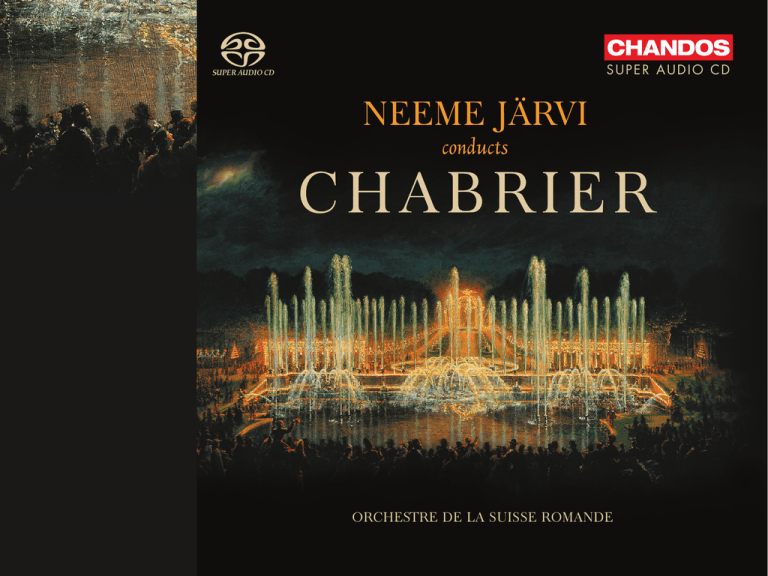
SUPER AUDIO CD orchestre de la suisse romande Emmanuel Chabrier Portrait engraving by Fernand Desmoulin (1853 – 1914) © Mary Evans Picture Library Emmanuel Chabrier (1841 – 1894) Orchestral Works 1 Joyeuse marche (c. 1888) 3:40 Overture to ‘Gwendoline’ (1879 – 85) 9:23 2 Orchestration by the composer of Rondo for piano four hands (1883, revised 1885) À Vincent d’Indy Tempo di marcia, molto risoluto e giocoso – Sans presser Allegro con fuoco – Maestoso Habanera (c. 1885) Andantino – Poco più mosso – Tranquillo – Più mosso – Meno mosso – Risoluto 4:11 4 España (1883) Rhapsody Allegro con fuoco – Serrez peu à peu le mouvement 6:12 3 3 5 Lamento (1874) for Orchestra 7:44 Alexandre Emard cor anglais Lent et très expressif – Pressez un peu le mouvement – Meno mosso largamente – Calme et doux – A tempo [I] – Plus lent (comme en se perdant) 6 Bourrée fantasque (1897) 6:44 Transcription for Large Orchestra by Felix Mottl (1856 – 1911) of an original piece for piano (1891) À mon ami Édouard Risler Très animé et avec beaucoup d’entrain – Istesso tempo – Molto moderato – A tempo vivo – Molto moderato quasi misurato – Tempo I molto risoluto – Sempre molto vivo – Sempre molto risoluto Suite pastorale (c. 1888) 19:05 Orchestration by the composer of Nos 6, 7, 4, and 10 from Dix Pièces pittoresques for piano (1880) 7 I Idylle. Andantino, poco con moto – Doux 8 II Danse villageoise. Allegro risoluto 9 III Sous-bois. Andantino – Meno mosso 10 IV Scherzo-valse. Allegro vivo – Più mosso – Tempo I. Allegro vivo 4 4:03 4:43 4:07 6:02 Three movements from ‘L’Étoile’ (1877) 8:11 Overture. Moderato – Andantino – Allegro – Presto 12 Entr’acte before Act II. Allegro franco 13 Entr’acte before Act III. Mouvement de valse 5:01 11 1:18 1:45 Two movements from ‘Le Roi malgré lui’ (1884 – 87) 15 14 12:28 Fête polonaise. Allegro molto animato – Più moderato e molto rubato – Vivo – Poco meno mosso – Tempo I moderato – Vivo – Stringendo – Sempre molto vivo – Molto vivo 6:55 Danse slave. Allegro con brio 5:27 TT 78:42 Orchestre de la Suisse Romande Bogdan Zvoristeanu concert master Neeme Järvi 5 Chabrier: Orchestral Works 1877 with L’Étoile, on a splendidly silly but, on its own terms, entirely coherent plot set in the court of the decidedly unstable King Ouf, given to punishing malefactors with a chair equipped with a sharp spike which travels… upwards. The Overture tells us that ceremony is to play its part, even if we cannot guess what fun Chabrier will later have with the concept. In this potpourri of tunes yet to come, none is in the ‘right’ key, just to keep them fresh. The first entr’acte follows the scene of Ouf ’s disappointment when an impending impalement is interrupted by news that the stars are foretelling the death of Ouf himself if the punishment goes ahead; the tune of the entr’acte is simply that of the impaling scene, in yet a third key. The second entr’acte goes back to a scene in Act I in which the young hero, Lazuli, is awoken by prolonged tickling. Introduction In 1897, an Auvergnat workman in Paris was arrested for hitting a man who had insulted him – by calling him ‘Auvergnat’. No doubt then, Emmanuel Chabrier (1841 – 1894) had an end to keep up when, at the age of fifteen, in 1856, he arrived in Paris from the Auvergne with his parents. And until he succumbed to illness in the early 1890s, he succeeded to a remarkable extent in being his own man on the composing front, bringing many a breath of fresh air into the capital’s hothouse atmosphere. The impression he gave of being an unlettered peasant, reinforced by his nearspherical frame, was at once countermanded by his sparkling conversation, and continues to be so by his utterly original music. Overture and two Entr’actes from ‘L’Étoile’ In fact, far from being unlettered, Chabrier was highly educated, if largely through his own efforts, and for some years he worked in the civil service where his efficiency and beautiful handwriting were much admired. After three attempts at comic opera – two in collaboration with Verlaine – he finally achieved success in Lamento A couple of years before L’Étoile, Chabrier had written a short Lamento for orchestra – not, to our ears, exactly a revolutionary work, but the committee of the Société nationale de musique hummed and hawed over it for 6 his orchestral masterpiece España, together with a liberal dose of sex… His letters to his publisher are eloquent on the subject of the Spanish women: more than eighteen months, before finally letting it loose on the Parisian public in 1878. They received it coldly, so that one critic blamed L’Étoile for giving a false idea of what this composer was capable of: ‘we shall soon see him take his place’, wrote the said critic, ‘among the most serious of our young composers and even the most “advanced”.’ Chabrier’s marking, Lent et très expressif, characterises the music perfectly, up to its wonderful die-away ending, of a kind later copied by Debussy. On the beach, those señoras possessed of a well-developed bosom often have trouble remembering to do up their costumes securely. From now on I shall carry buttons and thread with me. To be of service is my greatest desire. His friend Henri Duparc was amazed on hearing España at its first performance in 1883, claiming that Chabrier had left Paris orchestrating like anyone else and had returned with his gift transformed. Indeed, so overwhelming is the work’s instrumental colour that we may easily overlook the command which Chabrier had of his craft. He clearly wanted to get across the obsessional quality of Spanish music (another feature copied by his French followers), and of the 509 bars of España, no fewer than 160 actually contain the tonic chord of F major. España In 1880, Chabrier went to hear Tristan und Isolde in Munich – an occasion when, d’Indy tells us, after a certain amount of gasping and snuffling, Chabrier burst out with ‘Ten years of my life I’ve been waiting to hear that [opening] A on the cellos!’ Wagner’s music was to shadow his own for the rest of his life, but his next major work owed nothing to the German master. He had now retired from his job to devote himself to composing, and from July to December 1882 he and his family took an extended holiday in Spain. But for Chabrier it was very much a working holiday, noting down folk tunes and the extraordinary variety of rhythms with which he was surrounded. He put many of them into Habanera The effects of his Spanish holiday can also be heard in his Habanera, first published in 1885 as a piano piece in D flat major. Traditionally, his D major orchestral version, first played in 1888, has been dated to that year, but this is 7 contradicted by the composer’s note to the piano version, stating that none the worse for leaning occasionally on that to Die Meistersinger von Nürnberg, which Chabrier had copied out in the early 1860s as a way of learning orchestration. Less widely acknowledged is his debt to Berlioz, one of his gods from earliest years, and whose Harold en Italie he arranged for piano duet as late as 1876: for instance, the long melody, lasting almost a minute, heard both in the middle and at the end of the overture, exhibits a quality of Berlioz’s in seeming on the point of sprawling out of control before, cat-like, landing unexpectedly in a state of perfect balance. The overture as a whole prepares perfectly for a drama of violence, treachery, and passion. in order to facilitate the reading of this transcription, the Composer has written the left hand part on two staves – almost certainly the first time this practice had been adopted in French piano music. It would seem therefore that Chabrier wrote the piece originally for orchestra, but for some reason withheld performance of this version for three years – perhaps he was afraid of becoming typecast. Overture to ‘Gwendoline’ For six years from 1879 Chabrier had been working on Gwendoline, a two-act dramatic opera on a libretto by Catulle Mendès (1841 – 1909), set in Britain in what he called ‘barbarous times’. To the extent that such a subject can be understood as part of an Anglo-Celtic cult, as followed by, among others, Édouard Lalo (1823 – 1892) in his opera Le Roi d’Ys of 1888, we can say that Chabrier was following Wagner’s advice to French composers to mine the wealth of French and Celtic legend and leave the Norse ones well alone. Even so, Wagner’s shadow can at times be felt over Chabrier’s shoulder in both orchestration and harmony, and the splendid Overture (a Beecham favourite) is Fête polonaise and Danse slave from ‘Le Roi malgré lui’ A month after Gwendoline was premiered, in Brussels in April 1886, the Opéra Comique in Paris agreed to put on Chabrier’s next opera, Le Roi malgré lui. This was itself an opéra-comique, interspersing its tale of almost impenetrably complex politicking with jolly arias and tuneful, energetic dances. The plot, in which, as Chabrier’s friend Vincent d’Indy said, people go in and out, arriving when they ought to leave, or leaving when they ought to stay where they are, has challenged producers to this day, so that much wonderful music lies 8 pretty well unknown. Instead we have equally inventive dances such as the ‘Fête polonaise’ (in a letter still barely printable well over a century later, Chabrier whimsically envisaged turning the stage over to an orgy, and then hiring a hypnotist to come and calm everybody down), and the vigorous ‘Danse slave’, a version for orchestra alone of the choral opening to Act III, set in an inn, where preparations are being made to celebrate the arrival of Henri, the new king of Poland. they harked back to the harpsichord pieces of Couperin and Rameau – the same directness of utterance, with all striving so deeply absorbed as to be inaudible. Joyeuse marche The last two pieces on this disc celebrate Chabrier as a life force of extraordinary energy and élan. One of the happiest occasions in his life was the concert that he conducted in Angers on 4 November 1888, containing not only España, but the first performances of the Habanera and the Suite pastorale, as well as of a couple of pieces called Prélude pastoral and Marche française. The popularity of all these works was settled by the reaction of the orchestra at the first rehearsal, even though it started at 8.30 am: Chabrier wrote to his wife, Suite pastorale In 1880 Chabrier had written his Dix Pièces pittoresques for piano, and over the next few years he orchestrated four of them to form the Suite pastorale, premiered in 1888. Like several of his other works, they look back to his childhood in the Auvergne – a backwater which he had escaped with enormous relief but which, in the best Proustian fashion, gained from being seen through the glass of memory. The four pieces are grouped in two parallel pairs. From the gently pulsing ‘Idylle’ (which was to persuade Poulenc to become a composer) we move to the raucous ‘Danse villageoise’; and then again from the sultry shade of ‘Sous-bois’ into the sunny high spirits of the ‘Scherzo-valse’. César Franck had observed of the original piano versions that The March is a crazy piece; the orchestra was splitting its sides. Its title being revised from Marche française to Marche joyeuse to Joyeuse marche, it has long been one of the composer’s most popular works, blending subtle rhythmic shifts and acrobatic key changes with a coruscating panoply of orchestral sound. Bourrée fantasque The last years before the death of Chabrier from syphilis in 1894 were sad ones, not 9 least because his doctors tried to alleviate the symptoms by forbidding him to get up at or before dawn to compose, as he had always done. But his final piece, the Bourrée fantasque for piano of 1891, betrays no signs of fatigue or waning imagination. The bourrée was a dance especially popular in the Auvergne, where it was generally performed in clogs. The specimen by Chabrier is certainly ‘cloggy’ in parts, but there is also a hint of Spain in the repeated notes. He wrote to its dedicatee, his friend the pianist Édouard Risler (1873 – 1929): collaboration with the Ballets russes of Sergey Diaghilev and served as Music Director from 1918 until 1967. Initially comprised of sixty-two musicians contracted for six months per year, it performed in Geneva, Lausanne, and other cities in the French-speaking part of Switzerland. In 1937, while scouting a summer home for the Orchestra, Ansermet became the instigator of the Lucerne Festival. His notable successors have included Armin Jordan, perceived as his spiritual heir, and Marek Janowski. The collaboration with Radio suisse romande, which began in the 1930s, quickly enhanced the renown of the Orchestra, as did its numerous recordings, often made at night immediately after concert or opera performances, and a burgeoning worldwide touring schedule. From its earliest days, it has promoted contemporary music, premiering works by Benjamin Britten, Claude Debussy, Arthur Honegger, Frank Martin, Darius Milhaud, Igor Stravinsky, and many later composers. Today comprising 113 full-time musicians, the Orchestre de la Suisse Romande appears regularly around the world, continuously making debut appearances in new venues (the Concertgebouw in Amsterdam in 2006, Teatro alla Scala in Milan in 2010, Philharmonic Hall in St Petersburg in 2012). It participates in I’ve manufactured for you a little piano piece which I think is quite fun and in which I’ve counted nearly 113 different sonorities!... It must be crazy and mad! Whether his own orchestration would have embraced that number we do not know, because he never got beyond the first sixteen bars. The version recorded here was made in 1897 by another friend, the Austrian conductor Felix Mottl (1856 – 1911). © 2013 Roger Nichols The history of the Orchestre de la Suisse Romande, which gave its inaugural concert on 30 November 1918, is intimately linked to Ernest Ansermet, a former maths teacher, who launched the Orchestra during his 10 performances of opera at the Grand Théâtre de Genève and organises an entire programme for young audiences. The arrival of Neeme Järvi marks the beginning of a new chapter in its history, to be defined by the Estonian master’s personality, legendary musical flair, and wide-ranging taste for repertoire. collaborated with soloists such as Janine Jansen, Martha Argerich, Mischa Maisky, Vadim Repin, Evgeny Kissin, Truls Mørk, Hélène Grimaud, and Vadim Gluzman. Highlights of an impressive discography of more than 450 recordings include critically acclaimed cycles of the complete symphonies of Prokofiev, Sibelius, Nielsen, and Brahms, as well as recent series of orchestral works by Halvorsen and Svendsen, and a cycle of symphonic arrangements by Henk de Vlieger of operas by Wagner. Neeme Järvi has also championed less widely known Nordic composers such as Wilhelm Stenhammar, Hugo Alfvén, and Niels W. Gade, and composers from his native Estonia, including Rudolf Tobias, Eduard Tubin, and Arvo Pärt. Among many international awards and accolades, he has received an honorary doctorate from the Music Academy of Estonia in Tallinn, the Order of the National Coat of Arms from the President of the Republic of Estonia, honorary doctorates of Humane Letters from Wayne State University in Detroit and the University of Michigan, as well as honorary doctorates from the University of Aberdeen and the Royal Swedish Academy of Music. He has also been appointed Commander of the North Star Order by King Carl XVI Gustaf of Sweden. The head of a musical dynasty, Neeme Järvi is one of today’s most respected maestros. He is Music and Artistic Director of the Orchestre de la Suisse Romande, Artistic Director of the Estonian National Symphony Orchestra, and Chief Conductor Emeritus of the Residentie Orchestra The Hague, as well as Music Director Emeritus of the Detroit Symphony Orchestra, Principal Conductor Emeritus of the Gothenburg Symphony Orchestra, and Conductor Laureate of the Royal Scottish National Orchestra. He has appeared as guest conductor with the Berliner Philharmoniker, Royal Concertgebouw Orchestra, Orchestre de Paris, Symphonieorchester des Bayerischen Rundfunks, Gewandhausorchester Leipzig, London Philharmonic Orchestra, BBC Symphony Orchestra, Bergen Philharmonic Orchestra, and Wiener Symphoniker, as well as, in the US, the Los Angeles Philharmonic and National Symphony Orchestra in Washington D.C., among others. He has 11 Chabrier: Orchesterwerke Einleitung Ein Arbeiter aus der Auvergne wurde 1897 in Paris verhaftet, weil er sich handgreiflich dagegen verwahrt hatte, als “Auvergner” beschimpft zu werden. Der fünfzehn-jährige Emmanuel Chabrier (1841 – 1894) hatte es also nicht leicht, als er aus dieser ländlichen Region mit der Familie in die Hauptstadt zog. Aber bevor ihm eine tückische Krankeit in den letzten Jahren die schöpferischen Kräfte raubte, gelang es ihm auf bemerkenswerte Weise, sich als eigenständiger Komponist durchzusetzen und immer wieder frischen Wind in die stickige Treibhausatmosphäre von Paris zu bringen. Wer von ihm den Eindruck eines dummen Bauern gewann, bestärkt durch den Anblick einer rundlichen Figur, sah sich im nächsten Moment durch geistreiche Unterhaltung und die bleibende Originalität seiner Musik getäuscht. als studierter Jurist tat er fast zwanzig Jahre Beamtendienst im Innenministerium, wo man seine Effizienz und schöne Handschrift bewunderte. Nach drei Ansätzen zu einer komischen Oper – zwei in Zusammenarbeit mit Verlaine – gelang ihm schließlich 1877 sein Erstlingserfolg mit L’Étoile, einer absurden aber in sich geschlossenen Geschichte über den törichten König Ouf, der seinen Geburtstag mit einer Hinrichtung zu feiern pflegt. Die Ouvertüre stellt Feierlichkeiten in Aussicht, ohne ahnen zu lassen, welchen Spaß Chabrier dem Konzept später abgewinnen wird. Die Melodien in dieser Vorschau stehen noch nicht in der “richtigen” Tonart und sorgen so später für Frische. Die erste Zwischenaktmusik – nach der Enttäuschung Oufs über den Abbruch der Pfählung, auf die er verzichtet, als ihm sein Astrologe eröffnet, der König werde seinem Opfer in den Tod folgen – ist eine melodische Fortsetzung der Pfählungsszene, in eine dritte Tonart versetzt. Die zweite Zwischenaktmusik erinnert an eine Szene aus dem 1. Akt, in der Lazuli, unser junger Held, wachgekitzelt wird. Ouvertüre und zwei Zwischenaktmusiken aus “L’Étoile” Dumm war Chabrier beileibe nicht. Seine musikalische Bildung hatte er sich zwar weitgehend autodidaktisch angeeignet, doch 12 Lamento Drei Jahre vor L’Étoile hatte Chabrier ein kurzes Lamento für Orchester komponiert – für heutige Ohren nicht gerade revolutionär, doch der Vorstand der Société nationale de musique rang mehr als achtzehn Monate lang mit sich, bevor das Stück schließlich 1878 freigegeben wurde. Die Pariser Öffentlichkeit reagierte dermaßen kühl, dass ein Kritiker glaubte, bei L’Étoile hätte man einen falschen Eindruck von den Fähigkeiten Chabriers gewonnen: unter dem Einfluss des Deutschen. Chabrier hatte inzwischen seine Beamtenstelle aufgegeben, um sich ganz der Musik zu widmen, und von Juli bis Dezember 1882 mit der Familie eine ausgedehnte Spanienreise unternommen. Für ihn war es ein Arbeitsurlaub, eine Gelegenheit zur Niederschrift der Volksweisen und ungemein vielschichtigen Rhythmik des spanischen Lebens. Viel davon verarbeitete er in seinem meisterhaften Orchesterwerk España, wobei er auch den weiblichen Reizen gegenüber nicht verschlossen war, wie die Korrespondenz mit seinem Verleger bezeugt: Wir werden ja bald sehen, wie er seinen Platz unter den ernsthaftesten und “progressivsten” unserer jungen Komponisten einnimmt. Oft versäumen es am Strand die Señoras, die schöne Busen haben, ihre Kleidung zuzuknöpfen. Von nun an werde ich stets Knöpfe und Faden bei mir tragen. Ich stehe immer gern zu Diensten. Chabriers Anweisung Lent et très expressif kennzeichnet die Musik perfekt – bis hin zu dem wundervollen Ausklang, wie man ihn später auch bei Debussy erleben sollte. Die Uraufführung der Rhapsodie España versetzte 1883 seinen Freund Henri Duparc in Erstaunen: In Paris hätte Chabrier noch wie jeder andere orchestriert, bevor die Spanienreise sein Talent transformiert hätte. Tatsächlich ist die Instrumentalfärbung des Werks so überwältigend, dass man leicht übersieht, mit welcher Kunstfertigkeit Chabrier sein Handwerk beherrschte. Eindeutig lag ihm daran, das hypnotische Wesen der spanischen Musik zu vermitteln España 1880 reiste Chabrier nach München, um Tristan und Isolde zu erleben; d’Indy zufolge war er so tief ergriffen, dass er schluchzte: Ich weiß, es ist albern, aber ich kann nicht dafür ... zehn Jahre meines Lebens habe ich darauf gewartet, dieses [erste] A auf den Cellos zu hören! Obwohl ihn Wagners Musik fortan begleiten sollte, stand sein nächstes großes Werk nicht 13 Gwendoline, ein dramatischer Zweiakter nach einem Libretto von Catulle Mendès (1841 – 1909), der zu “barbarischen Zeiten” in England spielt. Wenn man diese Thematik im Rahmen eines anglo-keltischen Kults versteht, wie ihn etwa Édouard Lalo (1823 – 1892) in seiner Oper Le Roi d’Ys von 1888 aufgriff, folgte Chabrier vielleicht dem Rat Wagners, dass französische Komponisten gut daran täten, aus der reichhaltigen französischen und keltischen Mythologie zu schöpfen, von nordischen Legenden aber die Finger zu lassen. Dennoch spürt man zuweilen den Geist Wagners in der Orchestrierung und Harmonik Chabriers, und der prächtigen Ouvertüre (einem Lieblingsstück Beechams) tut es keinen Schaden, dass sie sich hin und wieder an die der Meistersinger von Nürnberg anlehnt, die Chabrier um 1860 kopiert hatte, um die Orchestrierung zu erlernen. Weniger bekannt ist, dass er auch Berlioz verpflichtet war, einem seiner frühesten großen Idole, dessen Harold en Italie er noch 1876 für Klavier zu vier Händen gesetzt hatte: So zeichnet sich beispielsweise die weitläufige Melodie, die man fast eine Minute lang in der Mitte und am Ende der Ouvertüre hört, durch eine für Berlioz typische Eigenschaft aus: Was augenscheinlich im Begriff steht, aus dem (was ihm die Komponisten der französischen Moderne dann nachtaten), und von den 509 Takten der Rhapsodie enthalten nicht weniger als 160 die Tonika F-Dur. Habanera Die Nachwirkungen der Spanienreise machten sich auch in seiner Habanera bemerkbar, die 1885 zunächst als Klavierstück in Des-Dur veröffentlicht wurde. Üblicherweise datiert man die Orchesterversion D-Dur auf 1888, das Jahr ihrer Uraufführung, aber dem widerspricht eine Anmerkung Chabriers zur Klavierfassung: Um das Lesen dieser Transkription zu erleichtern, hat der Komponist den Part der linken Hand auf zwei Systemen geschrieben – mit hoher Wahrscheinlichkeit das früheste Beispiel für diese Lösung in der französischen Klaviermusik. Vermutlich komponierte Chabrier also das Werk von Anfang an für Orchester, hielt diese Fassung aber dann drei Jahre lang aus unbekannten Gründen zurück – vielleicht wollte er sich nicht typisieren lassen. Ouvertüre zu “Gwendoline” 1879 nahm Chabrier ein Projekt auf, das ihn sechs Jahre lang beschäftigen sollte: 14 Gleichgewicht zu geraten, findet unverhofft und katzengleich eine fußfeste Landung. Die ganze Ouvertüre bereitet uns perfekt auf das von Gewalt, Verrat und Leidenschaft erfüllte Drama vor. kaum zu zitieren wagt, den skurrilen Vorschlag, auf der Bühne eine Orgie zu veranstalten und dann einen Hypnotiseur kommen zu lassen, um die Leidenschaften zu beruhigen; der bravouröse “Danse slave”, eine Orchesterversion der Choreinleitung zum 3. Akt, kommt aus einer Schenke, wo die Vorbereitungen zur feierlichen Begrüßung Henris, des neuen Königs von Polen, laufen. Fête polonaise und Danse slave aus “Le Roi malgré lui” Einen Monat nach der Brüsseler Uraufführung von Gwendoline im April 1886 akzeptierte die Opéra Comique in Paris die nächste Oper Chabriers: Le Roi malgré lui. Als komische Oper war es ein Werk im Stil des Hauses: eine fast undurchdringliche Geschichte komplexer politischer Machenschaften, durchsetzt mit heiteren Arien und klangvollen, lebhaften Tänzen. Dem mit Chabrier befreundete Vincent d’Indy zufolge kommen und gehen die Leute; sie erscheinen, wenn sie abtreten sollten, oder entfernen sich, wenn ihr Bleiben angebracht wäre. Es ist eine Handlung, die bis auf den heutigen Tag beträchtliche Inszenierungsprobleme aufwirft, sodass viel herrliche Musik dem breiteren Publikum praktisch unbekannt ist. Ein besseres Schicksal ist den nicht minder einfallsreichen Tänzen beschieden. Zu der “Fête polonaise” machte Chabrier in einem Brief, aus dem man selbst nach mehr als einem Jahrhundert Suite pastorale 1880 hatte Chabrier seine Dix Pièces pittoresques für Klavier komponiert, und über die folgenden Jahre hinweg orchestrierte er vier dieser Stücke zu einer Suite pastorale, die 1888 zur Uraufführung kam. So wie in einigen anderen Werken nahm er auch hier Bezug auf seine Kindheitserlebnisse in der Auvergne – ein Provinzmilieu, dem er zwar mit enormer Erleichterung den Rücken gekehrt hatte, im Spiegel der Erinnerung jedoch nach bester Proustscher Manier mehr abgewinnen konnte. Die vier Stücke sind zu zwei Parallelpaaren gruppiert. Das sanft pulsierende “Idylle” (das in Poulenc den Wunsch weckte, Komponist zu werden) führt zu dem unbändigen “Danse villageoise”; und aus dem schwülen Schatten von “Sous-bois” schreiten wir zur sonnigen Heiterkeit von “Scherzo-valse”. César Franck hatte sich bei 15 den ursprünglichen Klavierstücken an die Cembalokompositionen Couperins und Rameaus – mit der gleichen Direktheit im Ausdruck und einem unhörbaren weil zutiefst verinnerlichten Streben – erinnert gefühlt. Bourrée fantasque Die letzten Lebensjahre Chabriers, denen die Syphilis 1894 ein Ende setzte, waren deprimierend – nicht zuletzt unter dem Einfluss seiner Ärzte, die auf eine Linderung der Symptome hofften, indem sie dem Komponisten untersagten, in aller Herrgottsfrühe die Arbeit aufzunehmen, wie er es eigentlich gewohnt war. Doch sein letztes Werk, die Bourrée fantasque für Klavier von 1891, verrät kein Anzeichen von Erschöpfung oder schwindender Imagination. Die Bourrée war als Volkstanz besonders populär in der Auvergne, wo man sie gewöhnlich in Holzschuhen tanzte. Chabriers Beispiel ist sicherlich streckenweise “klotzig”, doch spürt man in den wiederholten Noten auch einen Hauch von Spanien. Dem Widmungsträger Édouard Risler (1873 – 1929), einem befreundeten Pianisten, schrieb er: Joyeuse marche Die beiden letzten Stücke auf dieser CD feiern Chabrier als Inbegriff einer Vitalität von außergewöhnlicher Energie und Spannkraft. Eines der freudigsten Ereignisse in seinem Leben war das Konzert, dass er am 4. November 1888 in Angers leitete; auf dem Programm standen nicht nur España, sondern auch die Uraufführungen der Habanera und der Suite pastorale sowie zwei Stücke mit der Bezeichnung Prélude pastoral und Marche française. Die spätere Popularität dieser Werke deutete sich schon bei der ersten Probe an, die unmenschlich früh für 8.30 Uhr angesetzt war. Chabrier schrieb seiner Frau: Der Marche ist ein verrücktes Stück; das Orchester bog sich vor Lachen. Ich habe ein kleines Klavierstück für Sie produziert, das recht lustig ist und in dem ich fast 113 verschiedene Akkorde gezählt habe! ... Es muss dumm und verrückt sein! Mehrfach umbenannt – von Marche française über Marche joyeuse zu Joyeuse marche – hat sich dieser Marsch mit seinen subtilen rhythmischen Verschiebungen, akrobatischen Tonartwechseln und einer funkelnden Palette von Orchesterklängen als eines der größten Erfolgswerke des Komponisten erwiesen. Ob er diese Vielfalt in seine eigene Orchesterversion übernommen hätte, wissen wir nicht, denn über die ersten sechzehn Takte kam er nicht mehr hinaus. Die hier 16 eingespielte Fassung wurde 1897 von einem anderen Freund, dem österreichischen Dirigenten Felix Mottl (1856 – 1911), erstellt. einer Opernaufführung gemacht wurden, sowie zunehmende weltweite Tourneen ließen das Ansehen des Orchesters schnell wachsen. Seit seinen Anfängen ist das Orchester der zeitgenössischen Musik verpflichtet und spielte Uraufführungen von Werken von Benjamin Britten, Claude Debussy, Arthur Honegger, Frank Martin, Darius Milhaud, Igor Strawinsky und vielen späteren Komponisten. Das heute aus 113 Vollzeit-Musikern bestehende Orchestre de la Suisse Romande tritt regelmäßig in der ganzen Welt auf, wobei es immer wieder an neuen Spielorten debütiert (etwa 2006 im Concertgebouw in Amsterdam, 2010 im Teatro alla Scala in Mailand, 2012 in der Sankt Petersburger Philharmonie). Das Orchester nimmt an Opernaufführungen am Grand Théâtre de Gèneve teil und organisiert eine eigene Jugendreihe. Der Vertragsantritt Neeme Järvis bedeutet den Beginn eines neuen Kapitels in seiner Geschichte, das ganz im Zeichen der Persönlichkeit, des legendären musikalischen Flairs und des weitgefächerten Geschmacks des estnischen Maestros stehen wird. © 2013 Roger Nichols Übersetzung: Andreas Klatt Die Geschichte des Orchestre de la Suisse Romande, welches sein Gründungskonzert am 30. November 1918 gab, ist eng mit Ernest Ansermet verbunden, einem ehemaligen Mathematiklehrer, der das Orchester während seiner Zusammenarbeit mit Sergei Djagilews Ballets russes ins Leben rief und von 1918 bis 1967 als sein musikalischer Leiter fungierte. Das Orchester bestand ursprünglich aus zweiundsechzig Musikerinnen und Musikern, die für sechs Monate des Jahres engagiert waren, und konzertierte in Genf, Lausanne und anderen Städten der französischsprachigen Schweiz. Im Jahre 1937 wurde Ansermet auf der Suche nach einer Sommerresidenz für das Orchester zum Mitbegründer der Luzerner Festspiele. Zu seinen namhaften Nachfolgern gehörten Armin Jordan, der als sein geistiger Erbe galt, und Marek Janowski. Die 1930 begonnene Zusammenarbeit mit Radio suisse romande und zahlreiche Einspielungen, die oft noch am Abend direkt nach einem Konzert oder Neeme Järvi ist das Haupt einer Musikerdynastie und einer der renommiertesten Maestri unserer Zeit. Er ist Musikdirektor und Künstlerischer 17 Leiter des Orchestre de la Suisse Romande, Künstlerischer Leiter des Eesti Riiklik Sümfooniaorkester und emeritierter Chefdirigent des Residentie Orkest Den Haag, außerdem emeritierter Musikdirektor des Detroit Symphony Orchestra, emeritierter Chefdirigent der Göteborgs Symfoniker und Conductor Laureate des Royal Scottish National Orchestra. Als Gastdirigent ist er mit den Berliner Philharmonikern, dem Koninklijk Concertgebouworkest, dem Orchestre de Paris, dem Symphonieorchester des Bayerischen Rundfunks, dem Gewandhausorchester Leipzig, dem London Philharmonic Orchestra, dem BBC Symphony Orchestra, dem Bergen Filharmoniske Orkester und den Wiener Symphonikern aufgetreten, daneben in den USA unter anderem mit dem Los Angeles Philharmonic und dem National Symphony Orchestra in Washington D.C. Er hat mit Solisten wie Janine Jansen, Martha Argerich, Mischa Maisky, Vadim Repin, Jewgeni Kissin, Truls Mørk, Hélène Grimaud und Vadim Gluzman zusammengearbeitet. Zu den Höhepunkten einer eindrucksvollen Diskographie mit über 450 Einspielungen gehören von der Kritik gelobte Zyklen sämtlicher Sinfonien von Prokofjew, Sibelius, Nielsen und Brahms, außerdem eine jüngst erschienene Serie mit Orchesterwerken von Halvorsen und Svendsen sowie ein Zyklus sinfonischer Arrangements von Wagner-Opern des Komponisten Henk de Vlieger. Neeme Järvi hat sich auch für weniger bekannte nordische Komponisten wie Wilhelm Stenhammar, Hugo Alfvén und Niels W. Gade eingesetzt, sowie für Komponisten seiner estnischen Heimat, darunter Rudolf Tobias, Eduard Tubin und Arvo Pärt. Neben zahlreichen anderen internationalen Preisen und Ehrungen ist ihm die Ehrendoktorwürde der Estnischen Musikakademie in Tallinn verliehen worden, ebenso der Orden des Nationalen Wappens vom Präsidenten der Republik Estland; erhalten hat er auch die Ehrendoktorwürde der Wayne State University in Detroit und der University of Michigan in den USA, der University of Aberdeen in Schottland und der Königlich Schwedischen Musikakademie. König Carl XVI. Gustaf von Schweden ernannte ihn zum Kommandeur des Nordstern-Ordens. 18 Chabrier: Œuvres orchestrales étaient très admirées. Après trois essais à l’opéra comique – deux en collaboration avec Verlaine – il connut finalement le succès en 1877 avec L’Étoile. L’intrigue superbement stupide, mais à sa manière tout à fait cohérente, a pour cadre la cour du roi Ouf, personnage résolument instable, qui a coutume de punir les malfaiteurs au moyen d’une chaise équipée d’une pointe acérée orientée... vers le haut. L’Ouverture nous dit que la cérémonie a un rôle à jouer, même s’il nous est impossible de deviner quel est le comique que Chabrier va tirer de l’idée. Dans le pot-pourri des mélodies qui suivront, aucune n’est dans la “bonne” tonalité, juste pour leur garder leur fraîcheur. Le premier entr’acte suit la scène dans laquelle Ouf est dépité parce qu’un empalement sur le point d’avoir lieu est interrompu quand parvient la nouvelle que les astres prédisent la mort du roi si le châtiment se poursuit; la mélodie de l’entr’acte est tout simplement celle de la scène de l’empalement, cette fois dans une troisième tonalité. Le second entracte retourne à une scène de l’Acte I dans laquelle le jeune héros, Lazuli, est éveillé par de longs chatouillements. Introduction En 1897, un ouvrier auvergnat à Paris fut arrêté pour avoir frappé un homme qui l’avait insulté – il l’avait traité d’“Auvergnat”. Nul doute, dès lors, qu’Emmanuel Chabrier (1841 – 1894) aurait à se défendre, quand, à l’âge de quinze ans, en 1856, il arriva à Paris de son Auvergne natale avec ses parents. Et jusqu’à ce qu’il meure de maladie au début des années 1890, il réussit de manière remarquable à trouver sa propre voie dans l’univers de la composition, apportant souvent un souffle d’air frais dans l’atmosphère de serre de la capitale. L’impression qu’il donnait d’être un paysan illettré, renforcée par son gabarit presque sphérique, était immédiatement démentie par son brillant discours, et elle l’est toujours par l’étonnante originalité de sa musique. Ouverture et deux Entr’actes de “L’Étoile” En fait, loin d’être illettré, Chabrier était au contraire très instruit, il est vrai grâce surtout à un effort personnel; il travailla pendant quelques années dans la fonction publique où son efficacité et sa magnifique écriture 19 Lamento Deux ans avant L’Étoile, Chabrier avait écrit une courte pièce pour orchestre intitulée Lamento qui n’était pas vraiment, à l’entendre, une œuvre révolutionnaire, mais la Société nationale de musique tergiversa à son sujet pendant plus de dix-huit mois avant de finalement la dévoiler au public parisien en 1878. Elle fut reçue avec froideur, tant et si bien qu’un critique reprocha à L’Étoile de donner une fausse idée de ce dont le compositeur était capable. Voici ce qu’il écrit: cependant sa prochaine œuvre majeure ne fut redevable en rien au maître allemand. Chabrier avait maintenant donné sa démission à l’administration pour se consacrer à la composition, et de juillet à décembre 1882, il partit avec sa famille pour de longues vacances en Espagne. Pour Chabrier ce furent surtout des vacances de travail, au cours desquelles il prit note de mélodies folkloriques et de l’extraordinaire diversité de rythmes qui l’entouraient. Il reprit nombreux d’entre eux dans son chefd’œuvre orchestral España, avec une généreuse dose de sexe... Ses lettres à son éditeur sont éloquentes à propos des femmes espagnoles: Nous le verrons bientôt tenir son rang parmi nos jeunes compositeurs les plus sérieux et même les plus “avancés”. L’annotation Lent et très expressif de Chabrier caractérise parfaitement la musique, jusqu’au merveilleux épisode final qui va s’évanouissant, un style imité plus tard par Debussy. Sur la plage, les señoras qui ont une belle gorge oublient souvent d’agrafer solidement leur costume; j’emporterai désormais des boutons et du fil. Rendre service c’est ma passion. Son ami Henri Duparc fut stupéfait quand il entendit España lors de sa création en 1883, et déclara que Chabrier avait quitté Paris avec des dons d’orchestration qui n’étaient en rien exceptionnels et qu’il était revenu avec un talent métamorphosé. En effet, le coloris instrumental de l’œuvre est tellement prodigieux que la maîtrise qu’avait Chabrier de son art peut aisément nous échapper. Il voulait manifestement restituer le caractère España En 1880, Chabrier alla écouter Tristan und Isolde à Munich – à cette occasion, raconte d’Indy, après quelques halètements et soupirs, il explosa: Dix ans de ma vie que j’attends ce la [introductif ] de violoncelle! La musique de Wagner allait lui porter ombrage pour le restant de son existence, 20 travailla à Gwendoline, un opéra dramatique en deux actes sur un livret de Catulle Mendès (1841 – 1909) se déroulant en Angleterre en des “temps barbares”, selon son expression. Dans la mesure où pareil sujet peut être considéré comme faisant partie d’un culte anglo-celtique, auquel Édouard Lalo (1823 – 1892), entre autres, emboîta le pas dans son opéra Le Roi d’Ys de 1888, nous pouvons dire que Chabrier suivait le conseil que Wagner donnait aux compositeurs d’exploiter la richesse des légendes française et celtique et de ne pas toucher aux légendes nordiques. Ceci étant, on sent néanmoins planer de temps en temps l’ombre de Wagner au-dessus de Chabrier, à la fois dans l’orchestration que dans l’harmonie, et la splendide Ouverture (l’un des morceaux favoris de Beecham) ne souffre pas de prendre appui occasionnellement sur celle de Die Meistersinger von Nürnberg que Chabrier avait recopiée au début des années 1860 pour apprendre l’orchestration. Sa dette envers Berlioz, l’un des dieux de sa jeunesse, dont il arrangea Harold en Italie pour duo de pianos en 1876, est moins largement reconnue: la longue mélodie de presqu’une minute, par exemple, entendue à la fois au milieu et à la fin de l’ouverture révèle une qualité de Berlioz quand semblant sur le point d’échapper à tout contrôle, elle se pose de manière obsessionnel de la musique espagnole (un autre trait qui sera imité par ses disciples en France), et des 509 mesures de España, pas moins de 160 contiennent en fait l’accord tonique de fa majeur. Habanera Des échos de ses vacances en Espagne sont perceptibles aussi dans sa Habanera, éditée pour la première fois en 1885 en tant que pièce pour piano en ré bémol majeur. Traditionnellement, sa version orchestrale en ré majeur, créée en 1888, est datée de cette même année, mais la note du compositeur sur la version pour piano le contredit. Elle est libellée comme suit: Pour faciliter la lecture de cette transcription, l’Auteur a divisé en deux portées la partie de la main gauche. C’est presque avec certitude la première fois que cette pratique fut adoptée dans la musique française pour piano. Il semble dès lors qu’à l’origine Chabrier ait écrit la pièce pour orchestre, mais que pour une quelconque raison il ait différé l’exécution de cette version pendant trois ans – peut-être craignait-il que cela lui vaille d’être catalogué. Ouverture de “Gwendoline” Dès 1879, et pendant six ans, Chabrier 21 inattendue, à la manière d’un chat, en parfait équilibre. L’ouverture dans son ensemble est une préparation parfaite du drame, tissé de violence, de trahison et de passion. vigoureuse “Danse slave”, une version pour orchestre seul de l’ouverture chorale de l’Acte III, qui a pour cadre une auberge où les préparatifs pour la célébration de l’arrivée du nouveau roi de Pologne, Henri, vont bon train. Fête polonaise et Danse slave du “Roi malgré lui” Un mois après la création de Gwendoline à Bruxelles en avril 1886, l’Opéra Comique à Paris accepta de monter l’opéra que Chabrier composa ensuite, Le Roi malgré lui. Cette œuvre était elle-même un opéra-comique, le récit – une politicaillerie d’une complexité presque impénétrable – étant parsemé d’arias plaisants et de danses mélodieuses et dynamiques. L’intrigue dans laquelle, comme le disait Vincent d’Indy, ami de Chabrier, les personnages entrent et sortent, arrivent lorsqu’ils devraient partir, ou partent lorsqu’ils devraient rester où ils sont, a représenté jusqu’à ce jour un vrai défi pour les producteurs, et de ce fait une grande quantité de merveilleuse musique nous est presque inconnue. Nous avons à la place des danses tout aussi inventives comme la “Fête polonaise” (dans une lettre qu’il est presque impossible d’imprimer après bien plus d’un siècle, Chabrier a l’idée saugrenue de vouloir transformer la scène en une orgie, et puis d’engager un hypnotiseur pour venir calmer tout le monde) et la Suite pastorale En 1880, Chabrier avait écrit ses Dix Pièces pittoresques pour piano, et au cours des années qui suivirent, il en orchestra quatre d’entre elles pour former la Suite pastorale, créée en 1888. Comme plusieurs de ses autres œuvres, elles évoquent son enfance en Auvergne – un coin tranquille qu’il avait fui avec un énorme soulagement, mais que le compositeur, excellant dans le genre proustien, présente comme gagnant à être vu au travers des lunettes de la mémoire. Les quatre pièces sont regroupées en deux paires parallèles. De “Idylle” (qui allait persuader Poulenc de devenir compositeur) délicatement rythmé, nous passons aux sonorités âpres de la “Danse villageoise”; puis, encore, de l’ombre étouffante de “Sous-bois”, au climat joyeux et ensoleillé de “Scherzo-valse”. César Franck avait noté au sujet des versions pour piano originales qu’elles revenaient toujours aux pièces pour clavecin de Couperin et de Rameau – la même franchise dans l’expression, avec tout effet si profondément absorbé qu’il en devient inaudible. 22 Joyeuse marche Les deux dernières pièces sur ce disque célèbrent Chabrier, une force de la nature dotée d’un élan et d’une énergie extraordinaires. L’un des événements les plus heureux de sa vie fut le concert qu’il dirigea à Angers le 4 novembre 1888 lors duquel fut joué España et furent créées la Habanera et la Suite pastorale, ainsi que deux pièces intitulées Prélude pastoral et Marche française. La popularité de toutes ces œuvres fut établie par la réaction de l’orchestre lors de la première répétition, malgré le fait qu’elle débutât à 8h30; Chabrier écrivit à son épouse: de la maladie lui aient interdit de se lever à l’aube ou plus tôt encore pour composer, ce qu’il avait toujours fait, y était pour beaucoup. Mais sa dernière pièce, la Bourrée fantasque pour piano de 1891, ne trahit aucun signe de fatigue ou de déclin de son imagination. La bourrée était une danse particulièrement populaire en Auvergne où elle était généralement dansée en sabots. La pièce de Chabrier rend certes cet effet “heurté”, mais il y a aussi une touche espagnole dans les notes répétées. Il écrivit à son dédicataire, son ami le pianiste Édouard Risler (1873 – 1929): Je vous ai fabriqué un petit morceau de piano que je crois assez amusant et dans lequel j’ai compté près de 113 sonorités différentes!... Il faudra que ce soit imbécile et fou! La Marche est imbécile de drôlerie; les musiciens se tordaient. Son titre original Marche française fut changé en Marche joyeuse pour devenir ensuite Joyeuse marche. Cette pièce a été pendant longtemps l’une des œuvres les plus populaires de Chabrier, mêlant de subtiles variations rythmiques et des changements de tonalités acrobatiques à une brillante panoplie de sonorités orchestrales. Son orchestration aurait-elle embrassé ce nombre de sonorités, nous l’ignorons, car il ne dépassa jamais les seize premières mesures. La version enregistrée ici fut réalisée en 1897 par un autre ami de Chabrier, le chef d’orchestre autrichien Felix Mottl (1856 – 1911). © 2013 Roger Nichols Bourrée fantasque Les années qui précédèrent le décès de Chabrier en 1894 des suites d’une syphilis furent des années tristes, et le fait que les médecins pour tenter d’adoucir les symptômes Traduction: Marie-Françoise de Meeûs L’histoire de l’Orchestre de la Suisse Romande, qui donna son concert inaugural 23 le 30 novembre 1918, est étroitement liée à Ernest Ansermet, ancien professeur de mathématiques, qui lança cet orchestre au cours de sa collaboration avec les Ballets russes de Serge Diaghilev et en fut directeur musical de 1918 à 1967. Composé à l’origine de soixante-deux musiciens engagés par contrat pour six mois par an, il se produisit à Genève, Lausanne et dans d’autres endroits de la Suisse romande. En 1937, alors qu’il recherchait un point de chute estival pour l’orchestre, Ansermet devint l’instigateur du Festival de Lucerne. Parmi ses successeurs remarquables, on peut citer Armin Jordan, considéré comme son héritier spirituel, et Marek Janowski. La collaboration avec la Radio suisse romande, qui débuta dans les années 1930, développa rapidement la renommée de l’orchestre, de même que ses nombreux enregistrements, souvent réalisés la nuit après un concert ou une représentation d’opéra, et un programme florissant de tournées internationales. Depuis ses débuts, l’orchestre promeut la musique contemporaine, créant des œuvres de Benjamin Britten, Claude Debussy, Arthur Honegger, Frank Martin, Darius Milhaud, Igor Stravinsky et de nombreux compositeurs plus récents. Constitué aujourd’hui de cent treize musiciens employés à plein temps, l’Orchestre de la Suisse Romande se produit régulièrement dans le monde entier et fait régulièrement ses débuts dans de nouveaux lieux (le Concertgebouw d’Amsterdam en 2006, le Teatro alla Scala de Milan en 2010, la Philharmonie de Saint-Pétersbourg en 2012). Il participe à des représentations d’opéra au Grand Théâtre de Genève et organise un programme complet pour le jeune public. L’arrivée de Neeme Järvi marque le début d’un nouveau chapitre dans son histoire que définiront la personnalité, le flair musical légendaire et le goût d’un répertoire très vaste du maître estonien. À la tête d’une véritable dynastie musicale, Neeme Järvi est un des chefs d’orchestre les plus respectés d’aujourd’hui. Il est directeur musical et artistique de l’Orchestre de la Suisse Romande, directeur artistique de l’Orchestre symphonique national d’Estonie, chef principal émérite de l’Orchestre de la Résidence de la Haye, ainsi que directeur musical émérite du Detroit Symphony Orchestra, chef principal émérite de l’Orchestre symphonique de Göteborg et “Conductor Laureate” du Royal Scottish National Orchestra. Il s’est aussi produit en tant que chef invité avec les Berliner Philharmoniker, l’Orchestre royal du Concertgebouw, l’Orchestre de Paris, 24 le Symphonieorchester des Bayerischen Rundfunks, le Gewandhausorchester Leipzig, le London Philharmonic Orchestra, le BBC Symphony Orchestra, l’Orchestre philharmonique de Bergen et les Wiener Symphoniker, et également aux USA, avec le Los Angeles Philharmonic et le National Symphony Orchestra de Washington D.C., entre autres. Il a travaillé avec des solistes tels que Janine Jansen, Martha Argerich, Mischa Maisky, Vadim Repin, Evgeny Kissin, Truls Mørk, Hélène Grimaud et Vadim Gluzman. Parmi les grands moments d’une impressionnante discographie comptant plus de 450 enregistrements, figurent des cycles salués par la critique – les intégrales des symphonies de Prokofiev, Sibelius, Nielsen et Brahms – ainsi que des séries récentes consacrées aux œuvres orchestrales de Halvorsen et de Svendsen, sans oublier un cycle consacré aux arrangements symphoniques d’opéras de Wagner effectués par Henk de Vlieger. Neeme Järvi s’est également fait le défenseur de la musique de compositeurs nordiques moins connus du grand public, tels Wilhelm Stenhammar, Hugo Alfvén et Niels W. Gade, et de compositeurs originaires de son Estonie natale, dont Rudolf Tobias, Eduard Tubin et Arvo Pärt. Parmi les nombreuses récompenses et distinctions dont il a fait l’objet sur le plan international, Neeme Järvi a été fait docteur honoris causa de l’Académie de Musique d’Estonie à Tallinn, a reçu l’Ordre du Blason national des mains du président de la république d’Estonie, des doctorats honoris causa en Lettres de la Wayne State University de Detroit et de l’université du Michigan, ainsi que des doctorats honoris causa de l’université d’Aberdeen et de l’Académie royale de musique de Suède. Il a aussi été fait commandeur de l’Ordre de l’étoile polaire par le roi Carl XVI Gustaf de Suède. 25 A Message from RTS – Espace 2 Espace 2, the cultural channel of Radio Télévision Suisse (RTS), is once again delighted to be associated with a prestigious release featuring the Orchestre de la Suisse Romande (OSR). This collaboration does not date back all the way to the origins of the Orchestra (which already existed before radio came along), but it does recall the wishes of Ernest Ansermet. As soon as radio broadcasts began, the founder of the OSR realised that the principal radio channel in his district would certainly become an indispensable partner to a symphony orchestra of international stature. This spirit continues to the present day, as the RTS remains the foremost broadcasting channel for the OSR, offering the majority of the concerts performed by the Orchestra live, or as a deferred broadcast, for listeners in western Switzerland and, through the European Broadcasting Union, in Europe, the USA, and Japan. Less ephemeral than a radio broadcast, may this recording also enjoy a global destiny! Alexandre Barrelet Rédaction Culture RTS (Chief Culture Editor, RTS) 26 A Special Thanks Merging Technologies has worked for over twenty years providing the audio industry with some of the world’s most respected and sonically precise equipment, but when the Chandos team landed at the Victoria Hall, they were not even fully aware that they were actually going to become part of a world first. The Orchestre de la Suisse Romande approached us in May 2012 with a request to provide them with a system capable of high resolution 24-bit / 96 kHz multi-channel recording, and we felt that could be an extraordinary opportunity to deploy a brand new equipment range that relies on a network technology called RAVENNA. The Horus Networked Audio Interface allows audio to be distributed across standard networking technology while retaining the highest of fidelity. For the best sonic performance, it was decided to use one unit located near the stage, for shortest microphone cabling, and a second Horus two floors down in the monitoring room, where the rest of the recording equipment was situated. This was then easily connected together using a simple Ethernet switch. Combining the Horus unit with our Pyramix MassCore Digital Audio Workstation then provided Chandos with the ability actually to mix while the recording was taking place. We were happy to see them work in this manner, as Pyramix has been specially designed to be able to provide a real-time mixing interface at the same time as it records the highest-quality sound possible. So, we want to send a huge thanks to everyone at Chandos, the Victoria Hall staff, and the Orchestre de la Suisse Romande for helping to prove yet again that when quality comes first, Merging Technologies is able to provide the ultimate solutions. Claude Cellier President, Merging Technologies SA 27 You can now purchase Chandos CDs or download MP3s online at our website: www.chandos.net For requests to license tracks from this CD or any other Chandos discs please find application forms on the Chandos website or contact the Finance Director, Chandos Records Ltd, direct at the address below or via e-mail at [email protected]. Chandos Records Ltd, Chandos House, 1 Commerce Park, Commerce Way, Colchester, Essex CO2 8HX, UK. E-mail: [email protected] Telephone: + 44 (0)1206 225 200 Fax: + 44 (0)1206 225 201 www.facebook.com/chandosrecords www.twitter.com/chandosrecords Chandos 24-bit / 96 kHz recording The Chandos policy of being at the forefront of technology is now further advanced by the use of 24-bit / 96 kHz recording. In order to reproduce the original waveform as closely as possible we use 24-bit, as it has a dynamic range that is up to 48 dB greater and up to 256 times the resolution of standard 16-bit recordings. Recording at the 44.1 kHz sample rate, the highest frequencies generated will be around 22 kHz. That is 2 kHz higher than can be heard by the typical human with excellent hearing. However, we use the 96 kHz sample rate, which will translate into the potentially highest frequency of 48 kHz. The theory is that, even though we do not hear it, audio energy exists, and it has an effect on the lower frequencies which we do hear, the higher sample rate thereby reproducing a better sound. A Hybrid SA-CD is made up of two separate layers, one carries the normal CD information and the other carries the SA-CD information. This hybrid SA-CD can be played on standard CD players, but will only play normal stereo. It can also be played on an SA-CD player reproducing the stereo or multi-channel DSD layer as appropriate. 28 Microphones Thuresson: CM 402 (main sound) Schoeps: MK22 / MK4 / MK6 DPA: 4006 & 4011 Neumann: U89 CM 402 microphones are hand built by the designer, Jörgen Thuresson, in Sweden. Recording producer Brian Pidgeon Sound engineer Ralph Couzens Technical assistant Philippe Hamilton (Radio Télévision Suisse – Espace 2) Equipment Radio Télévision Suisse / Merging Technologies SA Editor Jonathan Cooper A & R administrator Sue Shortridge Recording venue Victoria Hall, Geneva, Switzerland; 27 – 29 June 2012 Front cover Illuminated Fountain Display in the Bassin de Neptune, Chateau de Versailles, in Honour of Prince Francisco de Assisi de Bourbon (1822 – 1902) on 21 August 1864 (oil on canvas) by Eugène-Louis Lami (1800 – 1890) © The Bridgeman Art Library / Getty Images Back cover Photograph of Neeme Järvi by Simon van Boxtel Design and typesetting Cassidy Rayne Creative (www.cassidyrayne.co.uk) Booklet editor Finn S. Gundersen Publishers Bärenreiter-Verlag, Kassel (Hugh Macdonald, editor) (Overture and Entr’actes from L’Étoile), Publications Enoch & Cie, Paris (Lamento) P 2013 Chandos Records Ltd C 2013 Chandos Records Ltd Chandos Records Ltd, Colchester, Essex CO2 8HX, England Country of origin UK 29 Grégory Maillot Orchestre de la Suisse Romande, with its Music and Artistic Director, Neeme Järvi, at Victoria Hall, Geneva CHSA 5122 CHANDOS DIGITAL CHANDOS CHANDOS 1 CHABRIER: ORCHESTRAL WORKS Orchestre de la Suisse Romande / Järvi 2 3 4 5 6 7 10 11 13 14 15 All tracks available in stereo and multi-channel This Hybrid CD can be played on any standard CD player. CHSA 5122 CHSA 5122 SA-CD, DSD and their logos are trademarks of Sony.

